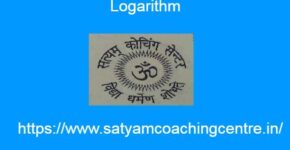Definite Integral by Use of Properties
1.गुणधर्मों के उपयोग द्वारा निश्चित समाकलन (Definite Integral by Use of Properties),योगफल की सीमा के रूप में निश्चित समाकलन कक्षा 12 (Definite Integral as Limit of a Sum Class 12):
गुणधर्मों के उपयोग द्वारा निश्चित समाकलन (Definite Integral by Use of Properties) के इस आर्टिकल में समाकलन के कुछ गुणधर्मों तथा समाकलन के प्रथम सिद्धान्त पर आधारित सवालों को हल करेंगे।
आपको यह जानकारी रोचक व ज्ञानवर्धक लगे तो अपने मित्रों के साथ इस गणित के आर्टिकल को शेयर करें।यदि आप इस वेबसाइट पर पहली बार आए हैं तो वेबसाइट को फॉलो करें और ईमेल सब्सक्रिप्शन को भी फॉलो करें।जिससे नए आर्टिकल का नोटिफिकेशन आपको मिल सके।यदि आर्टिकल पसन्द आए तो अपने मित्रों के साथ शेयर और लाईक करें जिससे वे भी लाभ उठाए।आपकी कोई समस्या हो या कोई सुझाव देना चाहते हैं तो कमेंट करके बताएं।इस आर्टिकल को पूरा पढ़ें।
Also Read This Article:- Indefinite Integrals in Class 12th
2.गुणधर्मों के उपयोग द्वारा निश्चित समाकलन पर आधारित उदाहरण (Illustrations Based on Definite Integral by Use of Properties):
25 से 33 तक के प्रश्नों में निश्चित समाकलनों का मान ज्ञात कीजिए।
Illustration:25. \int_{\frac{\pi}{2}}^\pi e^x\left(\frac{1-\sin x}{1-\cos x}\right) d x
Solution: \int_{\frac{\pi}{2}}^{\pi} e^x\left(\frac{1-\sin x}{1-\cos x}\right) d x \\ I=\int_{\frac{\pi}{2}}^\pi e^x\left(\frac{1}{1-\cos x}-\frac{\sin x}{1-\cos x}\right) d x
माना f(x)=-\frac{\sin x}{1-\cos x} \\ \Rightarrow f^{\prime}(x)=-\left[\frac{(1-\cos x) \cos x-\sin x \cdot \sin x}{(1-\cos x)^2}\right] \\ \Rightarrow f^{\prime}(x) =-\left[\frac{\cos x-\cos ^2 x-\sin ^2 x}{(1-\cos x)^2}\right] \\ =-\left[\frac{\cos x-1}{(1-\cos x)^2}\right] \\ =\frac{1-\cos x}{(1-\cos x)^2} \\ \Rightarrow f^{\prime}(x)=\frac{1}{1-\cos x}
अतः सूत्र \int e^x\left[f(x)+f^{\prime}(x)\right] d x=e^x f(x)+C से:
I=\left[\frac{-e^x \sin x}{1-\cos x}\right]_{\frac{\pi}{2}}^\pi \\ =-\frac{e^\pi \sin \pi}{1-\cos \pi}+ \frac{e^{\frac{\pi}{2}} \sin \frac{\pi}{2}}{1-\cos \frac{\pi}{2}} \\ =\frac{-e^\pi(0)}{1+1}+\frac{e^{\frac{\pi}{2}}(1)}{1-0} \\ \Rightarrow I=e^{\frac{\pi}{2}}
Illustration:26. \int_0^{\frac{\pi}{4}} \frac{\sin x \cos x}{\cos ^4 x+\sin ^4 x}
Solution: \int_0^{\frac{\pi}{4}} \frac{\sin x \cos x}{\cos ^4 x+\sin ^4 x} d x \\ I=\int_0^{\frac{\pi}{4}} \frac{\sin x \cos x}{\cos ^4 x+\sin ^4 x} d x
अंश व हर में \cos ^4 x का भाग देने पर:
put \tan x=t \Rightarrow \sec ^2 x d x=d t
जब x=0 तो t=0
जब x=\frac{\pi}{4} तो t=\tan \frac{\pi}{4}=1 \\ I=\int_0^1 \frac{t}{1+t^4} d t \\ =\frac{1}{2}\left[\tan ^{-1} t^2\right]_0^1 \\ =\frac{1}{2}\left[\tan ^{-1}(1)^2-\tan ^{-1} 0^2\right] \\ \Rightarrow I =\frac{1}{2} \cdot \frac{\pi}{4}=\frac{\pi}{8}
Illustration:27. \int_0^{\frac{\pi}{2}} \frac{\cos ^2 x d x}{\cos ^2 x+4 \sin ^2 x}
Solution: \int_0^{\frac{\pi}{2}} \frac{\cos ^2 x d x}{\cos ^2 x+4 \sin^2 x} \\ I=\int_0^{\frac{\pi}{2}} \frac{\cos ^2 x d x}{\cos ^2 x+4 \sin ^2 x} \\ =\int_0^{\frac{\pi}{2}} \frac{\cos ^2 x d x}{\cos ^2 x\left(1+4 \tan ^2 x\right)} \\ =\int_0^{\frac{\pi}{2}} \frac{\sec ^2 x d x}{\sec ^2 x\left(1+4 \tan ^2 x\right)} \\ =\int_0^{\frac{\pi}{2}} \frac{\sec ^2 x d x}{\left(1+\tan ^2 x\right)\left(1+4 \tan ^2 x\right)}
Put \tan x=t=\sec ^2 x d x=d t
जब x=0 तो t=\tan 0=0
जब x=\frac{\pi}{2} तो t=\tan \frac{\pi}{2}=\infty \\ \int_0^{\infty} \frac{d t}{\left(1+t^2\right)\left(1+4 t^2\right)}
आंशिक भिन्नों में वियोजित करने पर:
=\frac{1}{3} \int_0^{\infty}\left[\frac{4}{1+4 t^2}-\frac{1}{1+t^2}\right] d t \\ =\frac{4}{3} \int_0^{\infty} \frac{1}{1+4 t^2} d t-\frac{1}{3} \int_0^{\infty} \frac{1}{1+t^2} d t \\ =\frac{2}{3}\left[\tan ^{-1} 2 t\right]_0^{\infty}-\frac{1}{3}\left[\tan ^{-1} t\right]_0^{\infty} \\ =\frac{2}{3}\left(\tan ^{-1} \infty-\tan^{-1} 0\right)-\frac{1}{3}\left(\tan ^{-1} \infty- \tan^{-1} 0\right) \\ =\frac{2}{3}\left(\frac{\pi}{2}-0 \right)-\frac{1}{3}\left(\frac{\pi}{2}-0\right) \\ =\frac{\pi}{3}-\frac{\pi}{6}=\frac{2 \pi-\pi}{6} \\ \Rightarrow I=\frac{\pi}{6}
Illustration:28. \int_{\frac{\pi}{3}}^{\frac{\pi}{6}} \frac{\sin x+\cos x}{\sqrt{\sin 2 x}} d x
Solution: \int_{\frac{\pi}{6}}^{\frac{\pi}{3}} \frac{\sin x+\cos x}{\sqrt{\sin 2 x}} d x \\ I=\int_{\frac{\pi}{6}}^{\frac{\pi}{3}} \frac{\sin x+\cos x}{\sqrt{\sin 2 x}} d x \\ =\int_{\frac{\pi}{6}}^{\frac{\pi}{3}} \frac{(\sin x+\cos x) d x}{\sqrt{1-(1-2 \sin x \cos x)}} \\ =\int_{\frac{\pi}{6}}^{\frac{\pi}{3}} \frac{(\sin x+\cos x) d x}{\sqrt{1-(\sin 2 x+\cos 2 x-2 \sin x \cos x)}} \\ =\int_{\frac{\pi}{6}}^{\frac{\pi}{3}} \frac{(\sin x+\cos x)^2 x}{\sqrt{1-(\sin x-\cos x)^2}} \\ \text { put } \sin x-\cos x=t \\ (\cos x+\sin x) dx=dt
जब x=\frac{\pi}{6} तो t=\sin \frac{\pi}{6}-\cos \frac{\pi}{6} \\ \Rightarrow t=\frac{1}{2}-\frac{\sqrt{3}}{2}
जब x=\frac{\pi}{3} तो t=\sin \frac{\pi}{3}-\cos \frac{\pi}{3} \\ \Rightarrow t=\frac{\sqrt{3}}{2}-\frac{1}{2} \\ =\int_{\frac{1}{2}-\frac{\sqrt{3}}{2}}^{\frac{\sqrt{3}}{2}-\frac{1}{2}} \frac{1}{\sqrt{1-t^2}} d t \\ =\left[\sin ^{-1} t\right]_{\frac{1}{2}-\frac{\sqrt{3}}{2}}^{\frac{\sqrt{3}}{2}-\frac{1}{2}} \\ =\sin ^{-1}\left(\frac{\sqrt{3}}{2}-\frac{1}{2}\right)-\sin ^{-1}\left(\frac{1}{2}-\frac{\sqrt{3}}{2}\right) \\ =\sin^{-1} \left(\frac{\sqrt{3}-1}{2}\right)+\sin ^{-1}\left(\frac{\sqrt{3}-1}{2}\right) \\ \Rightarrow I=2 \sin ^{-1}\left(\frac{\sqrt{3}-1}{2}\right)
Illustration:29. \int_0^1 \frac{d x}{\sqrt{1+x}-\sqrt{x}}
Solution: \int_0^1 \frac{d x}{\sqrt{1+x}-\sqrt{x}} \\ I=\int_0^1 \frac{d x}{\sqrt{1+x}-\sqrt{x}} \times \frac{\sqrt{1+x}+\sqrt{x}}{\sqrt{1+x}+\sqrt{x}} \\ =\int_0^1 \frac{(\sqrt{1+x}+\sqrt{x}) dx}{1+x-x} \\ =\int_0^1(\sqrt{1+x}+\sqrt{x}) d x \\ =\left[\frac{2}{3}(1+x)^{\frac{3}{2}}+\frac{2}{3} x^{\frac{3}{2}} \right]_0^1 \\ =\frac{2}{3}(1+1)^{\frac{3}{2}}+\frac{2}{3}(1)^{\frac{3}{2}}-\frac{2}{3}(1+0)^{\frac{3}{2}}-\frac{2}{3} \times 0 \\ =\frac{2}{3} \times 2 \sqrt{2}+\frac{2}{3}-\frac{2}{3} \\ \Rightarrow I=\frac{4 \sqrt{2}}{3}
Illustration:30. \int_0^{\frac{\pi}{4}} \frac{\sin x+\cos x}{9+16 \sin 2 x} d x
Solution: \int_0^{\frac{\pi}{4}} \frac{\sin x+\cos x}{9+16 \sin 2 x} d x \\ I=\frac{1}{16} \int_0^{\frac{\pi}{4}} \frac{(\sin x+\cos x) d x}{\frac{9}{16}+2 \sin x \cos x} \\ =\frac{1}{16} \int_0^{\frac{\pi}{4}} \frac{(\sin x+\cos x) d x}{\frac{9}{16}+1-1+2 \sin x \cos x} \\ =\frac{1}{16} \int_0^{\frac{\pi}{4}} \frac{(\sin x+\cos x) d x}{\frac{25}{16}-(1-2 \sin x \cos x)} \\ =\frac{1}{16} \int_0^{\frac{\pi}{4}} \frac{(\sin x+\cos x) d x}{\frac{25}{16}-\left(\sin ^2 x+\cos ^2 x-2 \sin x \cos x\right)} \\ =\frac{1}{16} \int_0^{\frac{\pi}{4}} \frac{(\sin x+\cos x) d x}{\frac{25}{16}-(\sin x-\cos x)^2} \\ \text { Put } \sin x-\cos x=t \Rightarrow(\sin x+\sin x) d x=d t
जब x=0 तो t=\sin 0-\cos 0=-1
जब x=\frac{\pi}{4} तो t=\sin \frac{\pi}{4}- \cos \frac{\pi}{4}=0 \\ =\frac{1}{16} \int_{-1}^0 \frac{d t}{\left(\frac{3}{4}\right)^2-t^2} \\ =\frac{1}{2\left(\frac{5}{4}\right)} \times \frac{1}{16}\left[\log \left|\frac{\frac{5}{4}-t}{\frac{5}{4}+t}\right|\right]_{0}^1 \\ =\frac{1}{40}\left[-\log \frac{\frac{5}{4}}{\frac{5}{4}}+\log \frac{\frac{5}{4}+1}{\frac{5}{4}-1}\right] \\ =\frac{1}{40} \log 9 \\ \Rightarrow I =\frac{1}{40} \log 9
Illustration:31. \int_0^{\frac{\pi}{2}} \sin 2 x \tan^{-1} (\sin x) d x
Solution: \int_0^{\frac{\pi}{2}} \sin 2 x \tan ^{-1}(\sin x) d x \\ I=\int_0^{\frac{\pi}{2}} \sin 2 x \tan ^{-1}( \sin x) d x \\ =\int_0^{\frac{\pi}{2}} 2 \sin x \cos x \tan ^{-1}(\sin x) d x \\ \text{ put } \sin x=t \Rightarrow \cos x d x=d t
जब x=0 तो t=0
जब x=\frac{\pi}{2} तो t=1 \\ =2 \int_0^1 t \tan ^{-1} t d t
खण्डशः समाकलन करने पर:
=2 \tan ^{-1} t \int t d t-2 \int \left[\frac{d}{d t} \tan ^{-1} \int t dt \right] dt \\ =\left[t^2 \tan ^{-1} t\right]_0^1-\int_{0}^1 \frac{t^2}{1+t^2} d t \\ =(1)^2 \tan ^{-1} 1-0-\int_0^1 \frac{1+t^2-1}{1+t^2} d t \\ =\frac{\pi}{4}-\int_0^1 1 d t+\int_0^1 \frac{1}{1+t^2} d t \\ =\frac{\pi}{4}-[t]_0^1+\left[\tan ^{-1} t \right]_0^1 \\ \Rightarrow I =\frac{\pi}{4}-1+\tan ^{-1} 1-\tan ^1 0 \\ \Rightarrow I =\frac{\pi}{4} -1+\frac{\pi}{4} \\ \Rightarrow I=\frac{\pi}{2}-1
Illustration:32. \int_0^\pi \frac{x \tan x}{\sec x+\tan x} d x
Solution: \int_0^\pi \frac{x \tan x}{\sec x+\tan x} d x \\ I=\int_0^\pi \frac{x \tan x}{\sec x+\tan x} d x \cdots(1) \\ =\int_0^\pi \frac{(\pi-x) \tan (\pi-x)}{\sec (\pi-x)+\tan (\pi-x)} d x \\ I=\int_0^\pi \frac{(\pi-x) \tan x}{\sec x+\tan x} d x \cdots(2)
समीकरण (1) व (2) को जोड़ने पर:
2 I=\int_0^\pi \frac{(\pi-x) \tan x+x \tan x}{\sec x+\tan x} d x \\ =\int_0^\pi \frac{\pi \tan x}{\sec x+\tan x} d x \\ =\int_0^\pi \frac{\sin x}{1+\sin x} d x \\ =\int_0^\pi \frac{\pi \sin x(1-\sin x)}{(1+\sin x)(1-\sin x)} d x \\ =\pi \int_0^\pi \frac{\sin x-\sin ^2 x}{1-\sin ^2 x} d x \\ =\pi \int_0^\pi \frac{\sin x-\sin ^2 x}{\cos ^2 x} d x \\ =\pi \int_0^\pi\left(\frac{\sin x}{\cos ^2 x}-\frac{\sin ^2 x}{\cos ^2 x}\right) d x \\ =\pi \int_0^\pi \left(\sec x \tan x-\tan ^2 x\right) d x \\ =\pi \int_0^\pi\left(\sec x \tan x-\left(\sec ^2 x-1\right)\right) d x \\ =\pi \int_0^\pi \sec x \tan x d x-\pi \int_0^\pi \sec ^2 x d x +\pi \int_0^\pi 1 d x \\ =\pi[\sec x]_0^\pi-\pi[\tan x]_0^\pi+\pi[x]_0^\pi \\ =\pi[\sec \pi-\sec 0]-\pi[\tan \pi-\tan 0] +\pi \cdot \pi \\ =\pi(-1-1)+\pi^2 \\ =\pi^2-2 \pi \\ =\pi(\pi-2) \\ \Rightarrow 2 I= \pi(\pi-2) \\ \Rightarrow I=\frac{\pi}{2}(\pi-2)
Illustration:33. \int_1^4 \left[ |x-1|+|x-2|+|x-3| \right] d x
Solution: \int_1^4 \left[ |x-1|+|x-2|+|x-3| \right] d x
[1,4] पर x-1 \geq 0 ,
[1,2] पर x-2 \leq 0 और [2,4] पर x-2 \geq 0
[1,3] पर x-3 \leq 0 और [3,4] पर x-3 \geq 0 \\ I= \int_1^4(x-1) d x-\int_1^2(x-2) d x+\int_2^4(x-2) d x- \int_1^3(x-3) d x+\int_3^4(x-3) d x \\ =\left[\frac{x^2}{2}-x\right]_1^4-\left[\frac{x^2}{2}-2 x \right]_1^2 +\left[\frac{x^2}{2}-2 x\right]_2^4 -\left[\frac{x^2}{2}-3 x\right]_1^3+\left[\frac{x^2}{2}-3 x\right]_3^4 \\ = \frac{4^2}{2}-4-\frac{1^2}{2}+1-\left[\frac{2^2}{2}-2 \times 2-\frac{1^2}{2}+2 \times 1\right] +\left[\frac{4^2}{2}-2 \times 4-\frac{2^2}{2}+2 \times 2\right]-\left[\frac{3^2}{2}-3 \times 3-\frac{1^2}{2}+3 \times 1\right]+\frac{4^2}{2}-3 \times 4-\frac{3^2}{2}+3 \times 3 \\ =8-4-\frac{1}{2}+1-\left(2-4-\frac{1}{2}+2\right)+(8-8-2+2)-\left(\frac{9}{2}-9-\frac{1}{2}+3\right)+8-12 -\frac{9}{2}+9 \\ =4+\frac{1}{2}+\frac{1}{2}+2+2-4-\frac{9}{2}+9 \\ =\frac{8+1+1+4+4-8-9+18}{2} \\ \Rightarrow I=\frac{19}{2}
निम्नलिखित को सिद्ध कीजिए (प्रश्न 34 से 39 तक)
Illustration:34. \int_1^3 \frac{d x}{x^2(x+1)}=\frac{2}{3}+\log \frac{2}{3}
Solution: \int_1^3 \frac{d x}{x^2(x+1)}=\frac{2}{3}+\log \frac{2}{3} \\ \text{L.H.S.} \int_1^3 \frac{d x}{x^2(x+1)} dx
आंशिक भिन्नों में वियोजित करने पर:
\frac{1}{x^2(x+1)}=\frac{A}{x}+\frac{B}{x^2}+\frac{C}{x+1} \\ =\frac{A x(x+1)+B(x+1)+C x^2}{x^2(x+1)} \\ \Rightarrow 1=A x(x+1)+B(x+1)+C x^2 \\ \text { put } x=0 \Rightarrow B=1 \\ \text { Put } x=-1 \Rightarrow C=1 \\ \text { put } x=2 \\ 1=6 A+3 B+4 C \\ \Rightarrow 1=6 A+3+4 \Rightarrow A=-1 \\ \int_1^3\left(-\frac{1}{x}+\frac{1}{x^2}+\frac{1}{x+1}\right) d x \\ =\left[-\log x-\frac{1}{x}+\log (x+1)\right]_1^3 \\ =\left[\log \left(\frac{x+1}{x}\right)-\frac{1}{x}\right]_1^3 \\ =\log \frac{4}{3}-\log 2-\frac{1}{3}+1 \\ =\frac{2}{3}+\log \frac{2}{3}=R.H.S.
Illustration:35. \int_0^1 x e^x d x=1
Solution: \int_0^1 x e^x d x=1 \\ \text { L.H.S }= \int_0^1 x e^x d x \\ =x \int e^x d x-\int \left[ \frac{d}{d x}(x) \int e^x d x\right] d x \\ =\left[x e^x-e^x\right]_0^1 \\ =e-e-0 e^0+e^0 \\=1= R.H.S
Illustration:36. \int_{-1}^1 x^{17} \cos^4 x d x=0
Solution: \int_{-1}^1 x^{17} \cos ^4 x d x=0 \\ \text { L.H.S. } \int_{-1}^1 x^{17} \cos ^4 x d x \\ f(x)=x^{17} \cos ^4 x \\ f(-x)=(-x)^{17} \cos ^4(-x) \\ =-x^{17} \cos ^4 x \\ \Rightarrow f(-x)=-f(x)
अतः विषम फलन है
फलतः \int_{-1}^1 x^{17} \cos ^4 x d x=0
Illustration:37. \int_0^{\frac{\pi}{2}} \sin ^3 x dx=\frac{2}{3}
Solution: \int_0^{\frac{\pi}{2}} \sin ^3 x dx=\frac{2}{3} \\ \text{L.H.S.} \int_0^{\frac{\pi}{2}} \sin ^3 x d x \\ =\int_0^\pi \frac{3 \sin x-\sin 3 x}{4} d x \\ =-\frac{3}{4}[\cos x]_0^{\frac{\pi}{2}}+\frac{1}{12}[\cos 3 x]_0^{\frac{\pi}{2}} \\ =-\frac{3}{4}\left(\cos \frac{\pi}{2}-\cos 0\right)+\frac{1}{12}\left(\cos \frac{3 \pi}{2}-\cos 0\right) \\ =-\frac{3}{4} \times -1+\frac{1}{12}(-1) \\ =\frac{3}{4}-\frac{1}{12}=\frac{9-1}{12}=\frac{8}{12} \\ =\frac{2}{3}= \text{R.H.S}
Illustration:38. \int_0^{\frac{\pi}{4}} 2 \tan ^3 x=1- \log 2
Solution: \int_0^{\frac{\pi}{4}} 2 \tan ^3 x=1- \log 2 \\ \text{L.H.S.} \int_0^{\frac{\pi}{4}} 2 \tan ^3 x d x \\ =\int_0^{\frac{\pi}{4}} 2 \tan ^2 x \cdot \tan x \\ =\int_0^{\frac{\pi}{4}} 2\left(\sec ^2 x-1\right) \tan x d x \\ =2 \int_0^{\frac{\pi}{4}} \sec ^2 x \tan x d x-2 \int_0^{\frac{\pi}{4}} \tan x d x \\ =\left[\tan ^2 x\right]_0^{\frac{\pi}{4}}-2[\log \sec x]_0^{\frac{\pi}{4}} \\ =\tan ^2 \frac{\pi}{4}-\tan ^2 0-2 \log \sec \frac{\pi}{4}+2 \log \sec 0 \\ =1-2 \log \sqrt{2}+2 \log 1 \\ I=1-\log 2 =R.H.S
Illustration:39. \int \sin ^{-1} x d x=\frac{\pi}{2}-1
Solution: \int_0^1 \sin ^{-1} x d x=\frac{\pi}{2}-1 \\ \text{L.H.S.} \int_0^1 \sin ^{-1} x d x \\ =\sin ^{-1} x \int 1 \cdot d x-\int\left[\frac{d}{d x}\left(\sin ^{-1} x\right) \int 1 \cdot d x\right] d x \\ =\left[x \sin ^{-1} x\right]_0^1-\int \frac{x}{\sqrt{1-x^2}} d x \\ =(1) \sin ^{-1}(1)-0+\left[\sqrt{1-x^2}\right]_0^1 \\ =\frac{\pi}{2}+(0-1)=\frac{\pi}{2}-1 =R.H.S.
Illustration:40.योगफल की सीमा के रूप में \int_0^1 e^{2-3 x} का मान ज्ञात कीजिए।
Solution: \int_0^1 e^{2-3 x} d x \\ f(x)=e^{2-3 x} \\ n h=b-a \Rightarrow n h=1-0=1
जब h \rightarrow 0 तो n \rightarrow \infty \\ f(0)=e^{2-3(0)}=e^2 \\ f(0+h)=e^{2-3(0+h)} =e^{2-3 h} \\ f(0+2 h)=e^{2-3(0+2 h)}=e^{2-6 h} \\ f(0+3 h)=e^{2-3(0+3 h)}=e^{2-9 h} \\ \cdots \cdots \cdots \cdots \\ f(0+(n-1) h)=e^{2-3(0+(n-1) h)}=e^{2-3(n-1)h} \\ \int_a^b f(x) d x=\lim _{n \rightarrow \infty} h [f(a)+ f(a+h) +f(a+2 h)+f(a+3 h)+\cdots \cdots +f(a+(n-1) h] \\ \int_0^1 e^{2-3 x} d x=\lim _{h \rightarrow 0} h [f(0)+f(0+h)+f(0+2 h)+f(0+3 h)+\cdots \cdots +f(0+(n-1) h] \\ =\lim _{h \rightarrow 0} h \left[e^2+e^{2-3 h}+e^{2-6 h}+e^{2-9 h}+\cdots+e^{2-3(n-h)}\right] \\ =e^2 \lim _{h \rightarrow 0} h\left[1+e^{-3 h}+e^{-6 h}+e^{-9 h}+\cdots+e^{-3(n-h)}\right] \\ =e^2 \lim _{h \rightarrow 0} h\left[\frac{\left(e^{-3 h}\right)^n-1}{e^{-3 h}-1}\right] \\ =e^2 \lim _{h \rightarrow 0} h\left[\frac{e^{-3 n h}-1}{e^{-3 h}-1}\right] \\ =\frac{e^2}{-3} \times \frac{e^{-3 \times 1}-1}{\lim _{h \rightarrow 0}\frac{e^{-3 h}-1}{-3 h}} \\ =\frac{e^2}{-3} \times \frac{e^{-3}-1}{1}\left[\because \lim _{h \rightarrow 0}\frac{e^{-3 h}-1}{-3 h}=1 \right] \\ \Rightarrow \int_0^1 e^{2-3 x} d x=\frac{1}{3}\left(e^2-\frac{1}{e}\right)
41 से 44 तक के प्रश्नों में सही उत्तर का चयन कीजिए।
Illustration:41. \int \frac{d x}{e^x+e^{-x}} बराबर है:
(A) \tan ^{-1}\left(e^x\right)+C (B) \tan ^{-1}\left(e^{-x}\right)+C
(C) \log \left(e^x-e^{-x}\right)+C (D) \log \left(e^x+e^{-x}\right)+C
Solution: \int \frac{d x}{e^x+e^{-x}}=\int \frac{e^x}{e^{2 x}+1} dx \\ \text{put } e^x=t \Rightarrow e^x d x=d t \\ =\int \frac{1}{1+t^2} d t=\tan ^{-1} t=\tan ^{-1}\left(e^x\right)+c
अतः विकल्प (A) सही है।
Illustration:42. \int \frac{\cos 2 x}{(\sin x+\cos x)^2} d x बराबर है:
(A) \frac{-1}{\cos x+\sin x}+c (B) \log |\sin x+\cos x|+c
(C) \log |\sin x-\cos x|+c (D) \frac{1}{(\sin x+\cos x)^2} +c
Solution: \int \frac{\cos 2 x}{(\cos x+\sin x)^2} d x \\ =\int \frac{\cos ^2 x-\sin ^2 x}{(\cos x+\sin x)^2} d x \\ =\int \frac{\cos x-\sin x}{\cos x+\sin x} d x \\ \text { put }(\cos x+\sin x)=t \Rightarrow(\cos x-\sin x) d x=d t \\ =\int \frac{1}{t} d t \equiv \log t+C \\ =\log |\cos x+\sin x|+c
अतः विकल्प (B) सही है।
Illustration:43.यदि f(a+b-x)=f(x) तो \int_a^b x f(x) d x बराबर है:
(A) \frac{a+b}{2} \int_a^b f(b-x) dx (B) \frac{a+b}{2} \int_a^b f(b+x) d x
(C) \frac{b-a}{2} \int_a^b f(x) dx (D) \frac{a+b}{2} \int_a^b f(x) d x
Solution: \int_a^b x f(x) \cdot d x= \int_a^b(a+b-x) f(a+b-x) d x \\ =\int_a^b f(x) [(a+b)-x] d x \\ =(a+b) \int_a^b f(x) d x = \int_a^b x f(x) d x \\ \Rightarrow \int_a^b x f(x)=\frac{a+b}{2} \int_a^b f(x) d x
अतः विकल्प (D) सही है।
Illustration:44. \int_0^1 \tan ^{-1}\left(\frac{2 x-1}{1+x-x^2}\right) d x का मान है:
(A) 1 (B) 0 (C) -1 (D) \frac{\pi}{4}
Solution: \int_0^1 \tan ^{-1}\left(\frac{x+(x-1)}{1-x(x-1)}\right) d x \\ I=\int_0^1\left(\tan ^{-1} x+\tan ^{-1}(x-1)\right) d x \\ =\int_0^1\left[\tan ^{-1}(1-x)+\tan ^{-1}(-x)\right] d x \\=-\int_0^1 \tan ^{-1} x+\tan ^{-1}(x-1) \\ \Rightarrow 2 I=0 \Rightarrow I=0
अतः विकल्प (B) सही है।
उपर्युक्त उदाहरणों को हल करने पर गुणधर्मों के उपयोग द्वारा निश्चित समाकलन (Definite Integral by Use of Properties),योगफल की सीमा के रूप में निश्चित समाकलन कक्षा 12 (Definite Integral as Limit of a Sum Class 12) को समझ सकते हैं।
Also Read This Article:- Some Properties of Definite Integrals
3.गुणधर्मों के उपयोग द्वारा निश्चित समाकलन (Frequently Asked Questions Related to Definite Integral by Use of Properties),योगफल की सीमा के रूप में निश्चित समाकलन कक्षा 12 (Definite Integral as Limit of a Sum Class 12) से सम्बन्धित अक्सर पूछे जाने वाले प्रश्न:
प्रश्न:1.अपरिमेय फलनों का समाकलन कैसे ज्ञात करते हैं? (How is Integration of Irrational Algebraic Functions Calculated?):
उत्तर: \frac{1}{\sqrt{\left(a x^2+b x+c\right)}}
स्थिति:I.जब a धनात्मक हो:
I=\frac{1}{\sqrt{a}} \int \frac{dx}{\sqrt{\left(x+\frac{b}{2 a}\right)^2-\left(\frac{b^2-4 a c}{4 a^2}\right)}}
अब निम्न स्थितियाँ हो सकती हैं:
(i)जब b^2-4 a c>0 \\ I=\frac{1}{\sqrt{a}} \int \frac{d x}{\sqrt{\left(x+\frac{b}{2 a} \right)^2 -\left(\frac{\sqrt{b^2-4 a c}}{2 a}\right)^2}} \\ =-\frac{1}{\sqrt{a}} \cosh ^{-1}\left(\frac{2 a x+b}{\sqrt{\left(b^2-4 a c\right)}}\right)+c
(ii)जब b^2-4 a c<0 \\ I=\frac{1}{\sqrt{a}} \int \frac{d x}{\sqrt{\left(x+\frac{b}{2 a} \right)^2 +\left(\frac{\sqrt{b^2-4 a c}}{2 a}\right)^2}} \\ I=\frac{1}{\sqrt{a}} \sinh ^{-1} \left(\frac{2 a x+b}{\sqrt{(4 a c-b)}}\right)+c
(iii) b^2-4 a c=0 \\ I=\frac{1}{\sqrt{a}} \int \frac{d x}{\left(x+\frac{b}{2 a}\right)} \\ =\frac{1}{\sqrt{a}} \log \left(x+\frac{b}{2 a}\right)+c
स्थिति:II.जब a ऋणात्मक हो:माना a=-\alpha तो
I=\int \frac{d x}{\sqrt{-\alpha x^2+b x+c}} \\ =\frac{1}{\sqrt{\alpha}} \int \frac{1}{\sqrt{\frac{b^2+u a c}{4 \alpha^2}-\left(x-\frac{b}{2 \alpha}\right)^2}} \\ =\frac{1}{\sqrt{-a}} \sin^{-1} \left(\frac{-2 a x-b}{\sqrt{\left(b^2-4 a c\right)}}\right)+C
(ii) \int \frac{p x+q}{\sqrt{\left(a x^2+b x+c\right)}} d x \\ p x+q=A \frac{d}{d x}\left(a x^2+b x+c\right)+B
दोनों पक्षों की तुलना करने पर:
A=\frac{p}{2 a} तथा B=q-\frac{p b}{2 a} \\ I=\frac{p}{2 a} \int \frac{(2 a x+b)}{\sqrt{a x^2+b x+c}} d x+\int \frac{p-\left(\frac{p b}{2 a}\right)}{\sqrt{\left(a x^2+b x+c\right)}} d x
(iii) I=\int \sqrt{\left(a x^2+b x+c\right)} dx \\ =\sqrt{a} \int \sqrt{(x-\alpha)^2 \pm \beta^2} dx
(iv) I=\int (Px+q) \sqrt{\left(a x^2+b x+c\right)} dx \\ P x+q=A \frac{d}{d x}\left(a x^2+b x+c\right)+B \ p x+q=A(2 a x+b)+B
दोनों पक्षों की तुलना करने पर:
A=\frac{p}{2 a}, B=q-\frac{bp}{2a} \\ I=\frac{p}{2 a} \int(2ax+b) \sqrt{\left(a x^2+b x+c\right)} dx+\left(q-\frac{b q}{2a}\right) \int \sqrt{a x^2+b x+c} d x
प्रश्न:2.प्रथम सिद्धान्त से निश्चित समाकलन ज्ञात करने के सूत्र लिखो। (Write the Formulas to Find Definite Integral from First Principle):
उत्तर: (1 .) \int_a^b f(x) d x=\lim _{h \rightarrow 0} h[f(a)+f(a+h)+\cdots+f(a+(n-1) h] ,
जहाँ n \rightarrow \infty तथा h=\frac{b-a}{n}
(2.) \int_a^b f(x) d x=\lim _{h \rightarrow 0} h[f(a+h)+f(a+2 h)+\ldots \ldots+ f(a+nh)]
प्रश्न:3.अपरिमेय फलन किसे कहते हैं? (What is Irrational Function?):
उत्तर:यदि किसी फलन में चर की घात भिन्नात्मक हो,तो उसे अपरिमेय फलन कहते हैं,जैसे:
f(x)=x^{\frac{5}{2}}+x-1, g(x)=\frac{\sqrt{x}}{x+1}, h(x)=\frac{x^2-x^{\frac{1}{3}}}{x+1} इत्यादि
उपर्युक्त प्रश्नों के उत्तर द्वारा गुणधर्मों के उपयोग द्वारा निश्चित समाकलन (Definite Integral by Use of Properties),योगफल की सीमा के रूप में निश्चित समाकलन कक्षा 12 (Definite Integral as Limit of a Sum Class 12) के बारे में और अधिक जानकारी प्राप्त कर सकते हैं।
| No. | Social Media | Url |
|---|---|---|
| 1. | click here | |
| 2. | you tube | click here |
| 3. | click here | |
| 4. | click here | |
| 5. | Facebook Page | click here |
| 6. | click here |
Definite Integral by Use of Properties
गुणधर्मों के उपयोग द्वारा निश्चित समाकलन
(Definite Integral by Use of Properties)
Definite Integral by Use of Properties
गुणधर्मों के उपयोग द्वारा निश्चित समाकलन (Definite Integral by Use of Properties) के
इस आर्टिकल में समाकलन के कुछ गुणधर्मों तथा समाकलन के प्रथम सिद्धान्त पर आधारित
सवालों को हल करेंगे।
Related Posts
About Author
Satyam
About my self I am owner of Mathematics Satyam website.I am satya narain kumawat from manoharpur district-jaipur (Rajasthan) India pin code-303104.My qualification -B.SC. B.ed. I have read about m.sc. books,psychology,philosophy,spiritual, vedic,religious,yoga,health and different many knowledgeable books.I have about 15 years teaching experience upto M.sc. ,M.com.,English and science.








